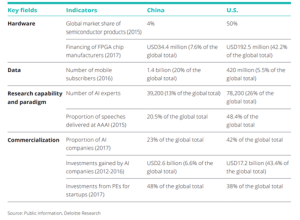an email newsletter released every month highlighting the latest articles, events, technical inquiries, and voices from the community
Artificial Intelligence (AI)/Machine-Learning (ML) Transition Timetable

Posted on October 13, 2022 | Completed on October 13, 2022 | By: Ma Xiu
How fast do AI/ML technologies transition from paper to fielded capability for the People’s Republic of China (PRC)?
Cybersecurity and Information Systems Information Analysis Center (CSIAC) subject matter experts from BluePath Labs (BPL) attempted to answer how fast the PRC can transition AI/ML technologies from the lab to the field. Although information was difficult to obtain using open sources, they found that the speed of transition depended on sector and technology.
According to a news article from June 2021 [1], the general message coming out of the 2020 China AI Industry Annual Conference (hosted by the Chinese Association of Artificial Intelligence) is that mature application of AI technology has so far been limited to speech recognition only. Other AI technologies, such as ML, computer vision, natural language processing, knowledge graphs, and intelligence will take “several years” to reach maturity, and autonomous vehicles are unlikely to appear in the next 10 years.
In an April 2020 report discussing AI weapons in China’s military innovation [2], Elsa B. Kania wrote the following:
“Based on publicly available information, the PLA’s trajectory in the development and potential employment of AI/ML-enabled and autonomous weapons systems remains uncertain. The maturity of these capabilities — as well as if, when, and to what extent weapons systems with greater levels of autonomy have been fielded — cannot be assessed with high confidence at this point.”
An October 2021 report by the Center for Security and Emerging Technology (CSET) noted that the People’s Liberation Army (PLA) is purchasing AI systems for “all manner of applications, including autonomous vehicles, intelligence analysis, decision support, electronic warfare and cyber operations” [3].
Deloitte released a report examining AI’s commercial applications in China [4]. The report included a comparison of key AI industry indicators between the United States and China (see Figure 1).

Figure 1: Comparison From Deloitte White Paper (Source: Deloitte [4]).
The speed of tech transition is sector and technology-dependent. According to a speech by Chinese Science and Technology then-Deputy Minister Wang Zhigang in 2016, China has yet to develop a set of standardized indicators to track and quantify technology transfer activities [5].
A case study conducted by BPL into the research and development (R&D) process of high-temperature materials used on Chinese hypersonic flight vehicles and missiles suggested that the process of transitioning technologies from the research lab to product prototyping took about 11 years [6].
In general, Chinese analysts have noted that the rate of successful transitions of technologies from the research lab to the marketplace remains low across the board. According to Deputy Director of the Development Research Center of the PRC State Council Wang Yiming, less than 10% of government-funded scientific research outcomes have been successfully commercialized, suggesting a failure in policies designed to enhance the synergy between the research performers and the innovation system at large [7]. The low conversion rates indicated a low rate of return on investment for the Chinese central and local governments, which together spent 1.1 trillion RMB (Chinese currency which is approx. 159.9 billion dollars) supporting broad scientific and technical information development in 2019 and 454 billion RMB (approx. 66 billion dollars) on research and development [8, 9].
The Chinese military has traditionally relied on state-owned defense corporations for equipment and technology needs. In recent years, however, the PLA has created multiple programs and channels to leverage private sector technologies more rapidly in response to defense technology innovation needs. Most of the programs are run by the Central Military Commission’s Science and Technology Committee and the Equipment Development Department. Some examples include the following:
- A “defense science and technology innovation rapid response task force” (sometimes characterized as China’s DIUx), which operates out of offices in Shenzhen, Dalian, and Chongqing [10]. In the first quarter of 2020 alone, the Shenzhen office released six sets of requests for proposals, seeking technologies ranging from unmanned aerial vehicle fast obstacle avoidance technology and software-defined multifunction sonar to preparation technology of ceramic coatings [11, 12].
- “Operation Acumen,” the Central Military Commission’s first attempt to leverage private sector innovation capabilities to rapidly produce a new application in support of PLA equipment development needs [13].
- “National Defense Science and Technology 173 Program,” which seeks commercial, off-the-shelf solutions [14].
REFERENCES
[1] Chinanews.com. “How Long Will It Take to Move From the Lab to Large-Scale Commercial AI?” https://www.chinanews.com.cn/cj/2021/06-03/9491501.shtml, 3 June 2021.
[2] Kania, E. B. “AI Weapons in China’s Military Innovation.” https://www.brookings.edu/ research/ai-weapons-in-chinas-military-innovation/, April 2020.
[3] Fedasiuk, R., J. Melot, and B. Murphy. “Harnessed Lightning: How the Chinese Military Is Adopting Artificial Intelligence.” Center for Security and Emerging Technology (CSET), Harnessed Lightning – Center for Security and Emerging Technology (georgetown.edu), October 2021.
[4] Deloitte. “Intelligence Driven by Innovation.“ Deloitte released China AI white paper, “Intelligence Driven by Innovation” – Deloitte released China AI Industry Whitepaper | Deloitte China | Innovation, accessed 2021.
[5] Zhigang, W. “Promote the Transformation of Scientific and Technological Achievements.” http://www.npc.gov.cn/npc/c541/201612/0834c1d81f4548b4a299f19eb884bd1b.shtml, 26 December 2016.
[6] Stone, A. “China’s Model of Science: Rationale, Players, Issues.” China Aerospace Studies Institute, https://www.airuniversity.af.edu/Portals/10/CASI/documents/Research/ Infrastructure/2022-02-07%20Model%20of%20Science.pdf, 7 February 2022.
[7] Yiming, W. “Increase the Conversion Rate of Technological Achievements Supported by Financial Funds.” Beijing Daily, http://www.cssn.cn/zx/201904/t20190408_4860831.shtml, 8 April 2019.
[8] National Bureau of Statistics. “Statistical Communiqué on National Science and Technology Expenditures in 2019.” http://www.stats.gov.cn/tjsj/zxfb/202008/t20200827_1786198.html, 27 August 2020.
[9] Fenzi, Z. “Report on China’s R&D Expenditure (2020).” http://m.zhishifenzi.com/news/ multiple/11239.html, 1 May 2021.
[10] Defense Science & Technology Innovation Rapid Response Force. “Publish the First Batch of Guidelines for Technology Fund Projects in 2021.” https://mp.weixin.qq.com/s/ wI8m2dkHrAxthitZOHJTJg, 23 February 2021.
[11] Military-Civilian Integration Public Service Platform Operation Management Office. “Notice on the Release of the Fourth Batch of Requirements in 2020 by the National Defense Science and Technology Innovation Rapid Response Team (Shenzhen).” https://www.hnjmrh.gov.cn/ newweb/newinfo/detail/3394/, 24 February 2020.
[12] Office of the Defense Science & Technology Innovation Rapid Response Force. “Notice on the Release of the Sixth Batch of Requirements in 2020 by the National Defense Science and Technology Innovation Rapid Response Team (Shenzhen).” https://www.hnjmrh.gov.cn/ newweb/newinfo/detail/3542/, 26 March 2020.
[13] Blue Ocean Evergreen Think Tank. “Announcement on the Collection of the First Batch of Innovative Achievements in 2021 for the ‘Smart Eye Action” of the Equipment Development Department of the Military Commission | With an introduction to the ‘Smart Eye Action’.” https://www.163.com/dy/article/G2DAMRJA0511DV4H.html, 9 February 2021.
[14] Defense Science & Technology Innovation Rapid Response Force. “Publish the First Batch of Guidelines for Technology Fund Projects in 2021.” https://mp.weixin.qq.com/s/wI8m2dkHrAxthitZOHJTJg, 23 February 2021.
Want to find out more about this topic?
Request a FREE Technical Inquiry!

